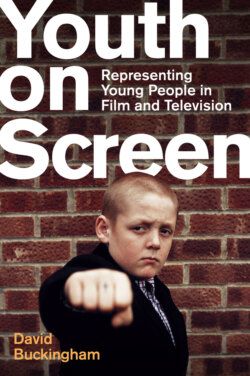Читать книгу Youth on Screen - David Buckingham - Страница 17
Conclusion
ОглавлениеBy the end of the 1950s, the juvenile delinquency film had largely run its course. Obviously, there have been countless films since that time which portray young people involved in antisocial behaviour or criminal acts of various kinds. From Easy Rider (1969), through The Outsiders (1983) and Kids (1995), and on to American Honey (2016), it’s easy to think of examples. But it makes little sense to think of these as JD films. ‘Juvenile delinquency’ represented a particular way of framing the apparent ‘problem’ of youth crime that was especially characteristic of the 1950s. Within a fairly short period, it had become almost a cliché.
Indeed, shortly afterwards, the whole debate about juvenile delinquency was famously parodied in the 1961 film of West Side Story (directed by Robert Wise and Jerome Robbins). In the song ‘Gee, Officer Krupke’, members of the Jets gang satirize the various explanations of delinquency and many of the solutions proposed by the justice system, psychologists and social workers. Are delinquents ‘sociologically sick’ or just ‘psychologically disturbed’? Are they ‘depraved on account they are deprived’? Is juvenile delinquency a ‘social disease’? And does it need to be treated by psychoanalysts or by the police? On one level, West Side Story might be seen as another film about juvenile delinquency; yet the most significant social problem it brings into focus is not so much about youth (or intergenerational conflict) as about race (in the ethnic rivalry between the two gangs). And, of course, like its original text Romeo and Juliet, it is primarily a love story, for which social tensions and divisions serve primarily as narrative obstacles to romantic fulfilment.
Both in the USA and in the UK, the JD films were a key part of the wider social debate about juvenile delinquency. They helped to construct and frame the problem in particular ways and to debate potential explanations and solutions for it. Yet, in doing so, they were also compromised, both by the movie industry’s attempts to reach the teenage audience, which would be vital for its future survival, and by its need to protect itself from public criticism. The industry actively courted controversy, not least because controversy is always good for box office; yet it also sought to reassure adult audiences of its responsibility and respectability. It is these tensions that account for the contradictions within and between the films I have discussed.
Yet, in parallel with these movies, film-makers on both sides of the Atlantic were also offering a rather different set of representations of youth – representations in which youth were depicted not as dangerous criminals but as harmless followers and participants in a commercially oriented consumer culture. It is to the fun-filled world of the pop film in the 1950s and 1960s that we turn in the following chapter.
